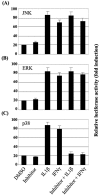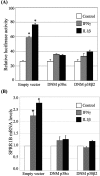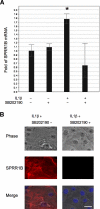Molecular mechanism of proinflammatory cytokine-mediated squamous metaplasia in human corneal epithelial cells
- PMID: 20042643
- PMCID: PMC2868474
- DOI: 10.1167/iovs.09-4677
Molecular mechanism of proinflammatory cytokine-mediated squamous metaplasia in human corneal epithelial cells
Abstract
Purpose: The cornified envelope protein small proline-rich protein 1B (SPRR1B) is a biomarker for squamous metaplasia. Proinflammatory cytokines IL-1beta and IFN-gamma are potent inducers of ocular surface keratinization and SPRR1B expression. Here the molecular mechanisms controlling SPRR1B gene expression in response to IL-1beta and IFN-gamma are elucidated.
Methods: A 3-kb fragment of the SPRR1B gene 5'-flanking region was amplified from human chromosome 1, sequentially deleted, and cloned into a luciferase vector. Constructs were transiently transfected into human corneal epithelial cells, and activity was assessed in response to IL-1beta, IFN-gamma, or basal medium. Functional cis-elements responding to IL-1beta and IFN-gamma were characterized by site-directed mutagenesis and gel mobility shift assay. Effects of mitogen-activated protein kinases p38, ERK, and JNK were assessed using inhibitors and dominant-negative mutants. Results were validated by real-time RT-PCR.
Results: The first 620 bp of the SPRR1B 5'-flanking region regulated constitutive expression and increased promoter activity in response to IL-1beta and IFN-gamma. Corresponding cis-elements for IL-1beta and IFN-gamma were bound by cAMP response element binding protein (CREB) and zinc-finger E-box binding homeobox 1 (ZEB1), respectively. Inhibition of p38 abolished the stimulatory effects of IL-1beta and IFN-gamma on SPRR1B, whereas inhibition of JNK and ERK had no effect. Dominant-negative mutants targeting p38alpha and p38beta2 blocked cytokine-induced SPRR1B promoter activity and mRNA expression.
Conclusions: SPRR1B is upregulated by the proinflammatory cytokines IL-1beta and IFN-gamma via p38 MAPK-mediated signaling pathways that lead to the activation of transcription factors CREB and ZEB1, respectively. These results identify key intracellular signaling intermediates involved in the pathogenesis of immune-mediated ocular surface squamous metaplasia.
Figures








References
-
- Beitch I. The induction of keratinization in the corneal epithelium: a comparison of the “dry” and vitamin A-deficient eyes. Invest Ophthalmol 1970;9:827–843 - PubMed
-
- Nelson JD, Havener VR, Cameron JD. Cellulose acetate impressions of the ocular surface: dry eye states. Arch Ophthalmol 1983;101:1869–1872 - PubMed
-
- Tseng SC. Staging of conjunctival squamous metaplasia by impression cytology. Ophthalmology 1985;92:728–733 - PubMed
-
- Jones DT, Monroy D, Ji Z, Pflugfelder SC. Alterations of ocular surface gene expression in Sjögren's syndrome. Adv Exp Med Biol 1998;438:533–536 - PubMed
Publication types
MeSH terms
Substances
Grants and funding
LinkOut - more resources
Full Text Sources
Research Materials
Miscellaneous

